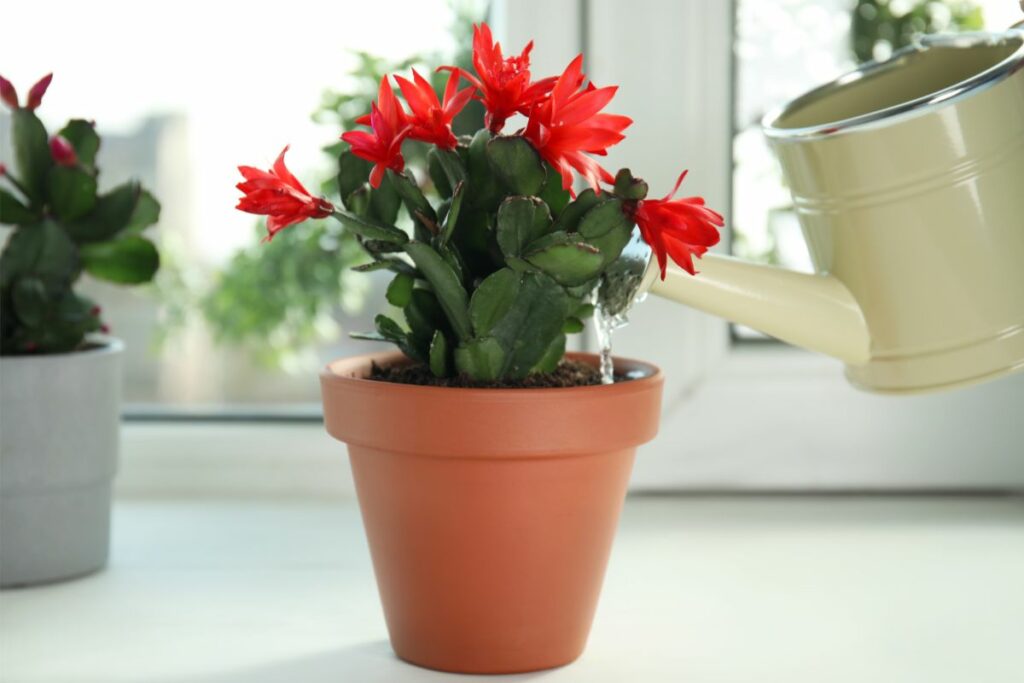Love the vibrant blooms of a Christmas Cactus?
What if you could enjoy them endlessly?
Learn the secrets to making your cactus bloom again and again.
Ready to transform your plant?
Let’s dive in!
Part 1: Essential Guidelines for Nurturing a Christmas Cactus

Optimal Placement
Select a location where your Christmas cactus can bask in diffused, plentiful light away from harsh rays, sparing its foliage from potential damage. Keep it away from chilly drafts and areas with wide temperature variances to maintain its health and flowering potential.
Balanced Lighting Conditions
To foster an environment conducive to flowering during the holidays, allow your Christmas cactus 12-14 hours of light during its bloom cycle, reducing this to 8-10 hours in off-peak times. This ensurea that your plant blossoms vibrantly for seasonal enjoyment.
Ideal Temperature Range
Maintain ambient temperatures around 60-70°F (15-24°C) for your cactus to prevent buds from falling prematurely. Position it at a safe distance from heating devices that can induce unnecessary plant stress.
- Watering Regimen:
- Flowering Period: Keep the soil consistently moist, yet ensure it is not drenched.
- Non-flowering Period: Let the topsoil dry slightly before the next watering, mitigating the risk of overhydration.
Humidity Preferences
Support your Christmas cactus with a moderate to high humidity setting. You can achieve this by placing a humidity tray with pebbles and water close to the plant or by incorporating a humidifier to sustain the ideal moisture levels.
- Nutritional Support:
- Fertilization Timing: Every fortnight in spring and summer with a diluted universal fertilizer.
- Fertilization Pause: Halt feeding during the blooming stage to avoid disrupting the plant’s natural cycle.
Pruning for Health and Bloom
Enhance your cactus’ shape and encourage a fuller growth by delicately pruning post-flowering. Snipping a few segments at the stem ends stimulates new branches and flowers.
Darkness for Bud Formation
To trigger bud development, your Christmas cactus requires longer nights. Create a dark period of 12-14 hours for about 6-8 weeks in autumn for a timely holiday display.
Propagation Practices
Multiply your collection by snipping healthy sections in the warmer months, allowing them to heal over for several hours before bedding in a well-draining mixture. Water these cuttings with care until they take root.
Pest and Disease Vigilance
Regularly inspect for signs of spider mites and mealybugs. In case of these unwelcome visitors, apply insecticidal soap or neem oil as a safe remedy. Promote good airflow and shy away from congesting your plants to stave off fungal afflictions.
Part 2: Uncommon Maintenance Advice for Christmas Cactus

Water Wisely with Suitable Water Sources
- Opt for rainwater or distilled water to irrigate your Christmas cactus, avoiding the accumulation of unwanted minerals found in regular tap water.
- Consistent use of these alternative water types ensures harmful salts don’t build up, promoting a more suitable environment for your plant’s growth.
Fresh Soil for Root Vitality
- Repot every 2-3 years with a new batch of well-draining soil, such as a mix designed for cacti or orchids.
- Refreshing the soil is vital to prevent compaction, which can affect drainage and root access to nutrients, thereby enhancing the plant’s flowering capacity.
Encourage a Resting Phase Post-Bloom
- Implement a dormancy period by reducing watering and keeping the plant in cooler conditions (50°F to 55°F/10°C to 13°C) for 4-6 weeks after flowering.
- This period of rest replicates the natural cycle of the plant and supports energy conservation and bud formation for the next flowering season.
Hand-Pollination for Increased Blooming
- Consider hand-pollinating using a soft brush to transfer pollen between flowers to improve the likelihood of fruiting and subsequent seed production.
- This practice not only potentially increases the number of flowers produced but also contributes to the overall vitality of the plant.
Avoid Nutrient Excess through Over-fertilization
- Use a balanced and diluted fertilizer judiciously during the growing season, and avoid fertilizing during the blooming phase.
- This prevents nutrient overdose and soil toxicity, supporting a healthier life cycle and promoting more generous and vibrant blooms.